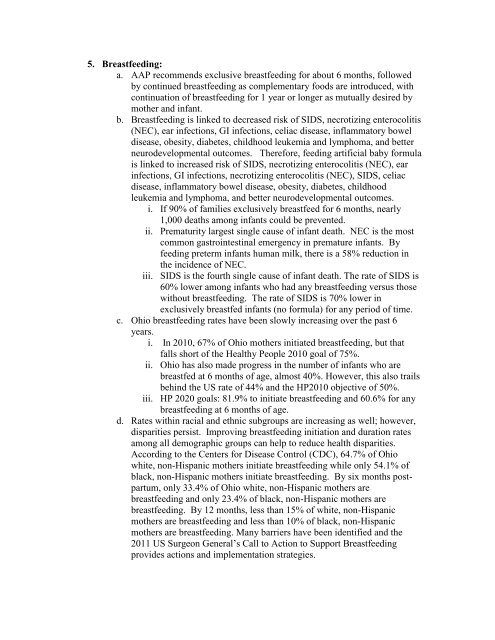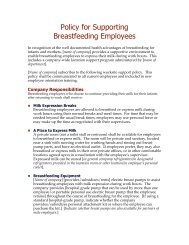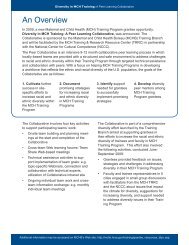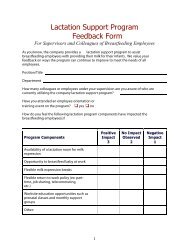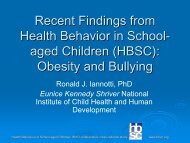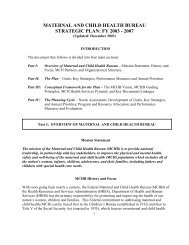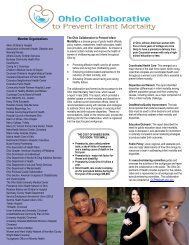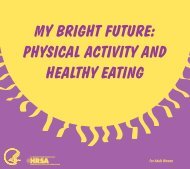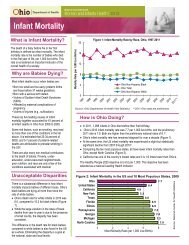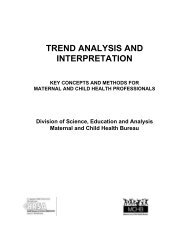improving infant mortality in ohio - Maternal and Child Health ...
improving infant mortality in ohio - Maternal and Child Health ...
improving infant mortality in ohio - Maternal and Child Health ...
You also want an ePaper? Increase the reach of your titles
YUMPU automatically turns print PDFs into web optimized ePapers that Google loves.
5. Breastfeed<strong>in</strong>g:a. AAP recommends exclusive breastfeed<strong>in</strong>g for about 6 months, followedby cont<strong>in</strong>ued breastfeed<strong>in</strong>g as complementary foods are <strong>in</strong>troduced, withcont<strong>in</strong>uation of breastfeed<strong>in</strong>g for 1 year or longer as mutually desired bymother <strong>and</strong> <strong><strong>in</strong>fant</strong>.b. Breastfeed<strong>in</strong>g is l<strong>in</strong>ked to decreased risk of SIDS, necrotiz<strong>in</strong>g enterocolitis(NEC), ear <strong>in</strong>fections, GI <strong>in</strong>fections, celiac disease, <strong>in</strong>flammatory boweldisease, obesity, diabetes, childhood leukemia <strong>and</strong> lymphoma, <strong>and</strong> betterneurodevelopmental outcomes. Therefore, feed<strong>in</strong>g artificial baby formulais l<strong>in</strong>ked to <strong>in</strong>creased risk of SIDS, necrotiz<strong>in</strong>g enterocolitis (NEC), ear<strong>in</strong>fections, GI <strong>in</strong>fections, necrotiz<strong>in</strong>g enterocolitis (NEC), SIDS, celiacdisease, <strong>in</strong>flammatory bowel disease, obesity, diabetes, childhoodleukemia <strong>and</strong> lymphoma, <strong>and</strong> better neurodevelopmental outcomes.i. If 90% of families exclusively breastfeed for 6 months, nearly1,000 deaths among <strong><strong>in</strong>fant</strong>s could be prevented.ii. Prematurity largest s<strong>in</strong>gle cause of <strong><strong>in</strong>fant</strong> death. NEC is the mostcommon gastro<strong>in</strong>test<strong>in</strong>al emergency <strong>in</strong> premature <strong><strong>in</strong>fant</strong>s. Byfeed<strong>in</strong>g preterm <strong><strong>in</strong>fant</strong>s human milk, there is a 58% reduction <strong>in</strong>the <strong>in</strong>cidence of NEC.iii. SIDS is the fourth s<strong>in</strong>gle cause of <strong><strong>in</strong>fant</strong> death. The rate of SIDS is60% lower among <strong><strong>in</strong>fant</strong>s who had any breastfeed<strong>in</strong>g versus thosewithout breastfeed<strong>in</strong>g. The rate of SIDS is 70% lower <strong>in</strong>exclusively breastfed <strong><strong>in</strong>fant</strong>s (no formula) for any period of time.c. Ohio breastfeed<strong>in</strong>g rates have been slowly <strong>in</strong>creas<strong>in</strong>g over the past 6years.i. In 2010, 67% of Ohio mothers <strong>in</strong>itiated breastfeed<strong>in</strong>g, but thatfalls short of the <strong>Health</strong>y People 2010 goal of 75%.ii. Ohio has also made progress <strong>in</strong> the number of <strong><strong>in</strong>fant</strong>s who arebreastfed at 6 months of age, almost 40%. However, this also trailsbeh<strong>in</strong>d the US rate of 44% <strong>and</strong> the HP2010 objective of 50%.iii. HP 2020 goals: 81.9% to <strong>in</strong>itiate breastfeed<strong>in</strong>g <strong>and</strong> 60.6% for anybreastfeed<strong>in</strong>g at 6 months of age.d. Rates with<strong>in</strong> racial <strong>and</strong> ethnic subgroups are <strong>in</strong>creas<strong>in</strong>g as well; however,disparities persist. Improv<strong>in</strong>g breastfeed<strong>in</strong>g <strong>in</strong>itiation <strong>and</strong> duration ratesamong all demographic groups can help to reduce health disparities.Accord<strong>in</strong>g to the Centers for Disease Control (CDC), 64.7% of Ohiowhite, non-Hispanic mothers <strong>in</strong>itiate breastfeed<strong>in</strong>g while only 54.1% ofblack, non-Hispanic mothers <strong>in</strong>itiate breastfeed<strong>in</strong>g. By six months postpartum,only 33.4% of Ohio white, non-Hispanic mothers arebreastfeed<strong>in</strong>g <strong>and</strong> only 23.4% of black, non-Hispanic mothers arebreastfeed<strong>in</strong>g. By 12 months, less than 15% of white, non-Hispanicmothers are breastfeed<strong>in</strong>g <strong>and</strong> less than 10% of black, non-Hispanicmothers are breastfeed<strong>in</strong>g. Many barriers have been identified <strong>and</strong> the2011 US Surgeon General’s Call to Action to Support Breastfeed<strong>in</strong>gprovides actions <strong>and</strong> implementation strategies.


